 |
Art & Architecture
Stained Glass: Light, Colors & Symbols
Christine Fitzgerald
The origins of stained glass are lost in history, but, by the year 900, depictions of Christ and biblical scenes were found in French, German and English Cathedrals. To make stained glass, the medieval artisan added metallic salts and oxides to molten glass. When the sun hit the glass it caused the beams to burst into the color spectrum and made the glass seem to glow from within.
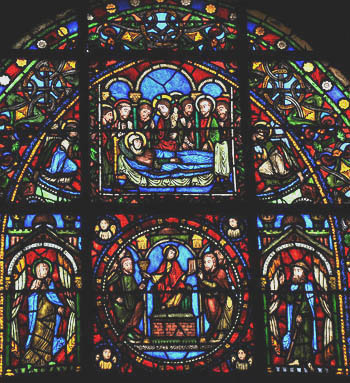
Scenes from the life of Our Lady in St. Denis, Paris |
Theophilus, a German monk, wrote a how-to manual for stained glass craftsmen in the year 1100 called De Diversis Artibus. Abbot Suger of St. Denis brought stained glass craftsmen into his Abbey and kept a journal of what was done. The Abbot truly believed that the presence of beautiful objects would lift men closer to God because our surroundings and our senses are the doorways to the soul. Ambiences are silent teachers of principles, either for the good or bad.
Abbot Suger applied the terminology of gemstones to the “sapphire” blue glass used so abundantly at St. Denis. Ruby red was another vibrant color used in many windows but the craftsmen had the dilemma of how to put the whites in the eyes of a devil such as the ruby demon in St. Ouen in Rouen or to make an intricate white design on a red skirt or to portray very light skin or to show white teeth from behind red lips. Their solution was laminating red and white pieces of glass together (flashing) and then scratching off the red to reveal the white below. This process was called abrading.
A living theology in stone and glass
Medieval craftsmen were more interested in creating a symbol to illustrate an idea or doctrine than just reproducing something natural or realistic. This was also true of their art, which was highly idealized.
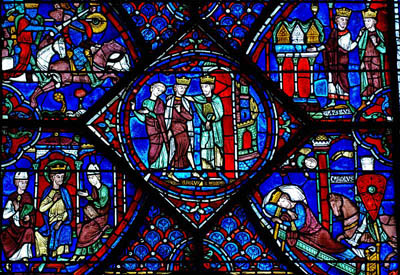
The Charlemagne window at Chartres depicts scenes from his life |
For example, a king would be depicted twice the size of his subjects to demonstrate his importance. Holy persons were painted with halos; reverence for the Blessed Mother was demonstrated in the use of crushed lapis lazuli in the paint used for her robe. Gold leaves, gold halos, gold robes etc were used to give a sense of richness, warmth and sacrality to their art. The artists were not seeking notoriety or worldly gain because most of their work was unsigned. Their efforts and their talents were employed to make the invisible visible. Their motivation was the glory of God.
The gothic cathedrals, and especially their stained glass windows, were correctly called the “Bible of the Poor.” The colors in the art and stained glass helped to present the teaching in a glorious and symbolic way.
Cathedral builders and stained glass craftsmen worked side by side with a theologian to assure that the doctrines were correctly interpreted and transmitted. To the medieval soul, the presence of Christ, ’the Light of the world,’ was visibly represented in the light streaming through their stained glass windows.
The Renaissance impoverished stained glasses
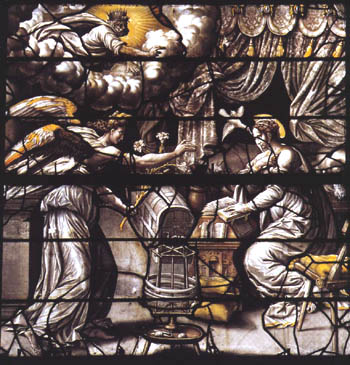
A Renaissance window at Saint Gervais-Sant Protais |
In the days leading up to the Renaissance, the way stained glass was made changed. In the 12th and 13th centuries, primary colors were used. Since everything was hand blown, the panes of glass were thick and uneven which made the light dance as it came through the panes. The vivid and brilliant colors flickered and created a kaleidoscope effect in the Cathedral.
It was unfortunate that, over time, the craftsmen began to paint glass white and then to portray the same biblical themes on the painted glass. They became “glass painters,” and the resultant windows were not nearly so beautiful and had lost their life. Their glow and shimmering qualities had been dulled, leaving lifeless, lusterless colored glass.
The lead outlines that were once accepted as a necessary and decorative element began to be viewed as something to be camouflaged. The windows became more of a picture than an atmosphere, and the previous glory and symbolism and innate beauty began to fade.
An unsurpassed sacrality
In describing the sacrality and mysterious beauty of the medieval cathedral, with its ancient stained glass windows, Eugene Viollett-le-Duc, a famous restorer of French cathedrals said,
“The opaline light which comes through these windows makes a sort of a veil, transparent in the extreme, under the lofty vaulting; it is crossed by the brilliant tones of the windows behind, which give the play of precious stones. The solid outlines then seem to waver like objects seen through a sheet of clear water. Distances change their values, and take depths in which the eye gets lost.
“With every hour of the day these effects are altered, and always with new harmonies which one never tires of trying to understand, but the deeper one’s study goes, the more astounded one becomes before the experience acquired by these artists, whose theories on the effects of color are still unknown to us.”
The chaotic modern stained glass
Comparing these medieval stained glass windows to the modern architecture, stained glass windows, art and vestments and liturgy of the 20th century Catholic Church leaves one mute with astonishment at what was explained to Catholics as a “necessary updating” of our Church.
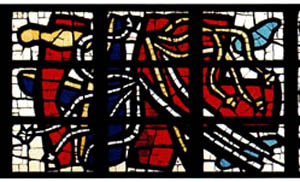
The confused Flagellation by Fernard Leger |
The new and modern colored glass windows of Marc Chagall and others are broken shards of glass in chaotic arrangement. The works of Jean Cocteau, Leger and Meistermann demonstrate that Faith and Revelation are subjective. There are no absolutes - only what our minds conjure up when looking at a modern stained glass window. There is no light of Christ, no warmth, usually no discernable message, no biblical lesson, no sense of wonder and tragically, no beauty to inspire admiration. They create a sort of grotesque ambience that chills and deflects souls rather than attracts.
It is not hard to imagine who or what benefits by this grotesque deformation of the arts or more importantly who has engineered it to the downfall of so many souls and even nations. It is the enemy of all of us, the Devil and his human cohorts, those powerful groups who promote this art.
What for me is hard to imagine is why good priests and Bishops, and even the laity, would allow this sort of sacrilege to continue on, year after year, in our churches, in the very homes on earth of our Good God.
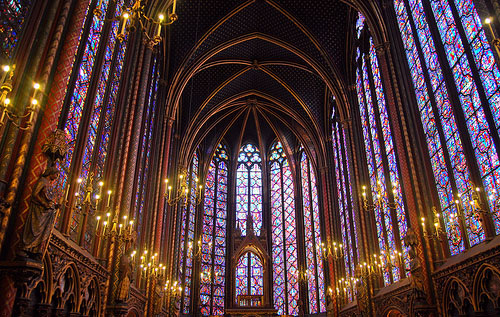
St. Chapelle in Paris
|

Posted July 21, 2010

Related Topics of Interest
 Reading Medieval Architecture Reading Medieval Architecture
 Medieval Church & Modern Churches Medieval Church & Modern Churches
 The Cathedral: Symbol of Paradise The Cathedral: Symbol of Paradise
 Churches of Hell Churches of Hell
 Tepee Churches Tepee Churches
 The Nefarious Power of Television The Nefarious Power of Television
 Courtesy: An Essential Element of the Catholic Home Courtesy: An Essential Element of the Catholic Home
 Manners Make Life Easier Manners Make Life Easier

Related Works of Interest
|
|
Art & Architecture | Hot Topics | Home | Books | CDs | Search | Contact Us | Donate

© 2002-
Tradition in Action, Inc. All Rights Reserved
|
 |

|